Attached files
| file | filename |
|---|---|
| 8-K - 8-K - Eagle Bulk Shipping Inc. | investorpresentation8k.htm |

Fourth Quarter 2017
Earnings Presentation
6 March 2018

2
Disclaimer
This presentation contains certain statements that may be deemed to be “forward-looking statements” within the meaning of Section 27A of the
Securities Act of 1933, as amended, Section 21E of the Securities Exchange Act of 1934, as amended, and the Private Securities Litigation
Reform Act of 1995, and are intended to be covered by the safe harbor provided for under these sections. These statements may include words
such as “believe,” “estimate,” “project,” “intend,” “expect,” “plan,” “anticipate,” and similar expressions in connection with any discussion of the
timing or nature of future operating or financial performance or other events. Forward-looking statements reflect management’s current
expectations and observations with respect to future events and financial performance. Where we express an expectation or belief as to future
events or results, such expectation or belief is expressed in good faith and believed to have a reasonable basis. However, our forward-looking
statements are subject to risks, uncertainties, and other factors, which could cause actual results to differ materially from future results expressed,
projected, or implied by those forward-looking statements.
The forward-looking statements in this presentation are based upon various assumptions, many of which are based, in turn, upon further
assumptions, including without limitation, examination of historical operating trends, data contained in our records and other data available from
third parties. Although Eagle Bulk Shipping Inc. believes that these assumptions were reasonable when made, because these assumptions are
inherently subject to significant uncertainties and contingencies which are difficult or impossible to predict and are beyond our control, Eagle Bulk
Shipping Inc. cannot assure you that it will achieve or accomplish these expectations, beliefs or projections.
The principal factors that affect our financial position, results of operations and cash flows include, charter market rates, which have declined
significantly from historic highs, periods of charter hire, vessel operating expenses and voyage costs, which are incurred primarily in U.S. dollars,
depreciation expenses, which are a function of the cost of our vessels, significant vessel improvement costs and our vessels’ estimated useful
lives, and financing costs related to our indebtedness. Our actual results may differ materially from those anticipated in these forward- looking
statements as a result of certain factors which could include the following: (i) changes in demand in the dry bulk market, including, without
limitation, changes in production of, or demand for, commodities and bulk cargoes, generally or in particular regions; (ii) greater than anticipated
levels of dry bulk vessel new building orders or lower than anticipated rates of dry bulk vessel scrapping; (iii) changes in rules and regulations
applicable to the dry bulk industry, including, without limitation, legislation adopted by international bodies or organizations such as the
International Maritime Organization and the European Union or by individual countries; (iv) actions taken by regulatory authorities; (v) changes in
trading patterns significantly impacting overall dry bulk tonnage requirements; (vi) changes in the typical seasonal variations in dry bulk charter
rates; (vii) changes in the cost of other modes of bulk commodity transportation; (viii) changes in general domestic and international political
conditions; (ix) changes in the condition of the Company’s vessels or applicable maintenance or regulatory standards (which may affect, among
other things, our anticipated drydocking costs); (x) the outcome of legal proceedings in which we are involved; and (xi) and other factors listed from
time to time in our filings with the SEC.
We disclaim any intent or obligation to update publicly any forward-looking statements, whether as a result of new information, future events or
otherwise, except as may be required under applicable security laws.
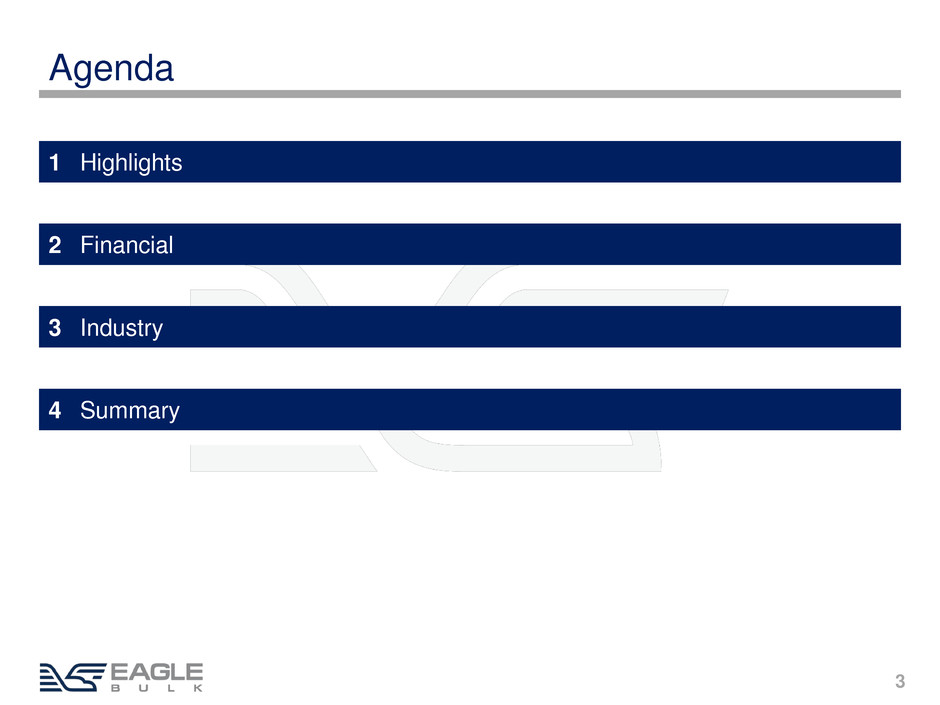
3
Agenda
1 Highlights
2 Financial
3 Industry
4 Summary

Highlights

$(14.5)
$(6.7)
$(3.4)
$(2.0)
$4.6
$9.3
$8.4
$17.2
$(17.5)
$(12.5)
$(7.5)
$(2.5)
$2.5
$7.5
$12.5
$17.5
1q16 2q16 3q16 4q16 1q17 2q17 3q17 4q17
Adjusted EBITDA
5
Executing on Business Strategy- 4q17 Highlights
BSI outperformance driving improved results
Outperformed BSI by USD 492 per day in 4q17 and
USD 783 per day for FY17
Generated USD 17.2 million in Adj. EBITDA* in 4q17
Fleet growth improving fleet makeup
Acquired a 2015-built Ultramax for USD 21.3 million-
purchased was financed by cash and debt (~40% LTV)
Refinancing extends debt tenor and decreases cost
Pushed tenor on all debt to 2022
Reduced annual interest expense by USD 3.6 million
Eliminated exposure to rising rates on 60% of debt
TCE relative performance is compared against Adj. net BSI= net BSI adjusted for the profile of owned fleet in terms of design. TCE is a non-GAAP financial
measure. Please refer to Appendix for the reconciliation of revenues to TCE
Adj. EBITDA= EBITDA adjusted to exclude certain non-cash, one-time, and other items (such as vessel impairment, gain / loss on sale of vessels, restructuring
expenses, loss on debt extinguishment, non-cash comp, and amortization of TC acquired) that Eagle believes are not indicative core operations.
Adj. EBITDA* (in millions)
Adj. EBITDA increasing
by over $126.8 million
on an annualized basis-
1q16 vs. 4q17
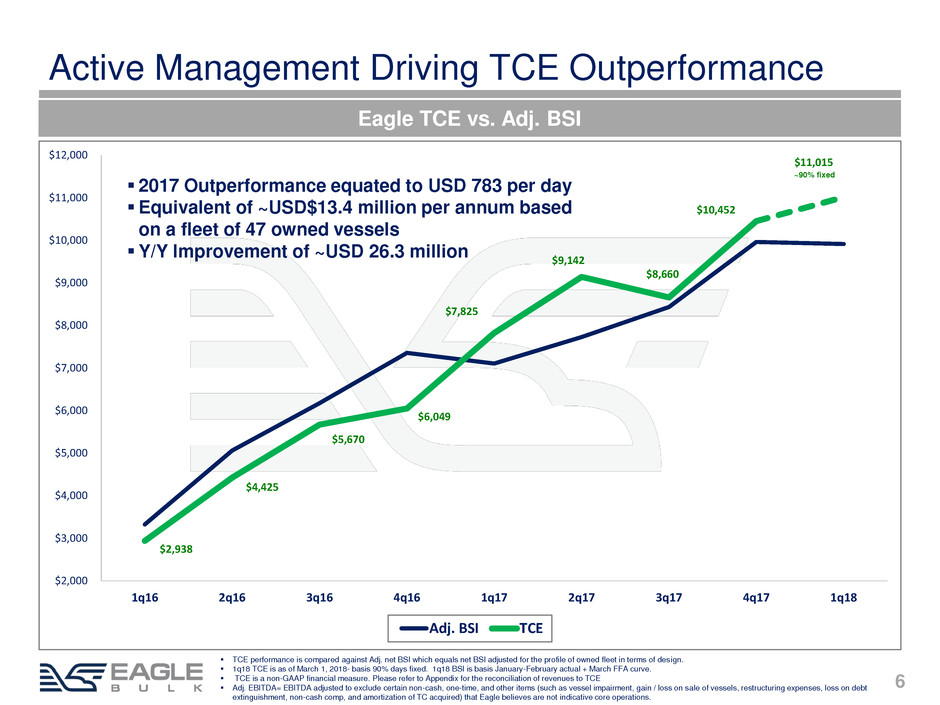
$2,938
$4,425
$5,670
$6,049
$7,825
$9,142
$8,660
$10,452
$11,015
$2,000
$3,000
$4,000
$5,000
$6,000
$7,000
$8,000
$9,000
$10,000
$11,000
$12,000
1q16 2q16 3q16 4q16 1q17 2q17 3q17 4q17 1q18
Adj. BSI TCE
6
Eagle TCE vs. Adj. BSI
TCE performance is compared against Adj. net BSI which equals net BSI adjusted for the profile of owned fleet in terms of design.
1q18 TCE is as of March 1, 2018- basis 90% days fixed. 1q18 BSI is basis January-February actual + March FFA curve.
TCE is a non-GAAP financial measure. Please refer to Appendix for the reconciliation of revenues to TCE
Adj. EBITDA= EBITDA adjusted to exclude certain non-cash, one-time, and other items (such as vessel impairment, gain / loss on sale of vessels, restructuring expenses, loss on debt
extinguishment, non-cash comp, and amortization of TC acquired) that Eagle believes are not indicative core operations.
Active Management Driving TCE Outperformance
2017 Outperformance equated to USD 783 per day
Equivalent of ~USD$13.4 million per annum based
on a fleet of 47 owned vessels
Y/Y Improvement of ~USD 26.3 million
~90% fixed

92 109
151
200
394
749
514
744
1046 1050
0
200
400
600
800
1000
1200
3q15 4q15 1q16 2q16 3q16 4q16 1q17 2q17 3q17 4q17
Chartered-in Fleet - Days
7
Third-party Timecharter-in Business
Eagle charters-in third party vessels in
order to cover cargo commitments, profit
from vessel-positioning arbitrage
opportunities, and increase overall
market coverage
Optimizing Platform Through Scale and Arbitrage

-
11
13
-
6
5
11
1
-
-
-
-
-
4
1
4
-
5
10
15
20
<5 5-7.5 7.5-10 10-12.5 12.5-15 >15
Existing Fleet Vessels Bought Vessels Sold
8
Dominant Player in Supramax/Ultramax Segment
Eagle fleet totals 47 Supramax/Ultramaxes
12 modern ships acquired
9 older/smaller vessels divested
AVOCET is sold and expected to be delivered to her new owners in 2q18
Source(s): VesselsValue
47
37
26
20
12
3 2
Eagle
Bulk
Scorpio Genco Star
Bulk
Navios
MH
Navios
MP
Golden
Ocean
Diana Safe
Bulkers
Supramax / Ultramax Handysize
Panamax Capesize
Eagle is uniquely focused on
the most versatile asset class
Eagle Fleet by Age Grouping Peer Group Fleet Profiles
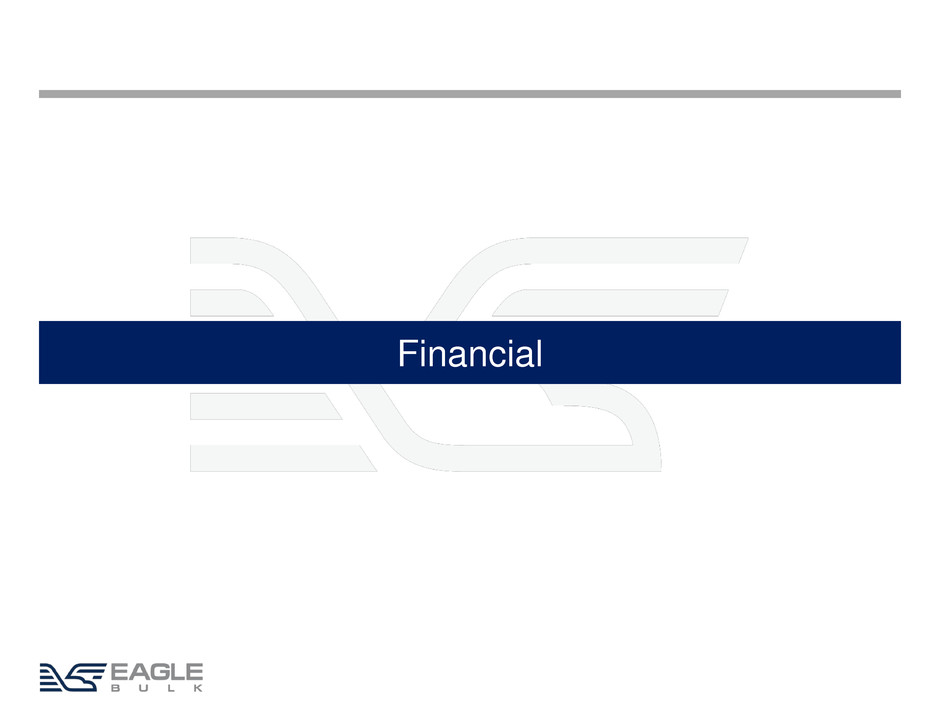
Financial

10
Earnings
Adjusted EBITDA represents EBITDA adjusted to exclude the items which represent certain non-cash, one-time and other items such as
vessel impairment, gain / loss on sale of vessels, restructuring expenses, loss on debt extinguishment, non-cash compensation expenses and
amortization of fair value below contract value of time charter acquired that the Company believes are not indicative of the ongoing
performance of its core operations.
$ Thousands except EPS 4q17 3q17 4q16 2017 2016
REVENUES, net of commissions 74,587$ 62,711$ 41,836$ 236,785$ 124,493$
EXPENSES
Voyage expenses 18,155 17,463 14,192 62,351 42,094
Vessel expenses 21,233 20,110 17,234 78,607 74,017
Charter hire expenses 11,312 9,652 5,866 31,284 12,845
Depreciation and amortization 9,196 8,981 9,979 33,691 38,884
General and administrative expenses 8,137 8,621 7,476 33,126 22,906
Restructuring expenses - - - - 5,869
Vessel Impairment - - 122,861 - 129,028
(Gain) / Loss on sale of vessels (34) (202) - (2,135) 102
Total operating expenses 67,999 64,625 177,608 236,924 325,745
OPERATING INCOME / (LOSS) 6,588 (1,914) (135,772) (139) (201,252)
OTHER EXPENSES
Interest expense (cash), net 4,385 3,265 6,030 12,700 9,724
Non Cash Interest Expense 3,718 4,429 491 16,026 11,860
(Gain) / Loss on derivatives 100 647 97 (38) 687
Loss on debt extinguishment 14,969 - - 14,969 -
Total other expense, net 23,172 8,341 6,618 43,657 22,271
Net Loss (16,584)$ (10,255)$ (142,390)$ (43,796)$ (223,523)$
Weighted average shares outstanding 70,368,623 70,329,252 48,106,827 69,182,302 20,565,652
EPS (Basic and Diluted) (0.24) (0.15) (2.96) (0.63) (10.87)
Adjusted EBITDA 17,219$ 8,397$ (1,961)$ 39,476$ (26,510)$

11
Balance Sheet + Liquidity Position
Liquidity Position ($ thousands)
Debt Maturity ($ thousands)
0
20,000
40,000
60,000
80,000
100,000
120,000
140,000
160,000
180,000
31-Mar 30-Jun 30-Sep 31-Dec 31-Mar 30-Jun 30-Sep 31-Dec
Cash & Certificate of Deposit Revolver Availaility
0
50,000
100,000
150,000
200,000
250,000
2017 2018 2019 2020 2021 2022
1st Lien Facility Norwegian Bond Ultraco
$ Thousands
Cash & Certificate of deposit 60,751
Undrawn availability 15,000
Total Liquidity as of December 31, 2017 75,751
December 31, 2017
$ Thousands
Cash & Certificate of Deposit 60,751
Other Current Assets 35,156
Vessels held for Sale 9,316
Vessels, net 692,438
Other Assets 10,689
Total Assets 808,350
Current Liabilities 26,823
Debt (including $4M current)* 317,684
Other Noncurrent Liabilities 2,678
Total Liabilities 347,185
Stockholder's Equity 461,165
Total Liabilities and Stockholder's Equity 808,350
December 31, 2017
Debt net of $8.5M of debt discount and deferred financing cost

12
Cash Flow
Cash Flow from Operations ($ millions)
2017 Cash Flow Change ($ millions)
-19.5 -13.2 -7.5 -5.3
-2.0 -3.8
7.3 5.9
-23.9
-10.1
-7.5
-4.5
2.1
4.9
2.7
12.8
1q16 2q16 3q16 4q16 1q17 2q17 3q17 4q17
Cash flow from operations
ex Changes in operating assets and liabilities

13
Cash Breakeven per Vessel per Day
2017
Breakdown
by Category
2016 Excluding one time extraordinary legal expenses
2018 Estimated figures
FY18e FY17 FY16 FY15
OPERATING
Vessel Expenses $ 4,825 $ 4,825 $4,803 $ 5,239
Drydocking 452 158 243 688
G&A 1,497 1,497 1,246 1,334
Total Operating 6,774 6,480 6,292 7,261
DEBT SERVICE 1,637 819 631 604
TOTAL CASH BREAKEVEN $ 8,411 $ 7,299 $6,923 $ 7,865
Vessel
Expenses
66%
Drydocking
2%
G&A
21%
Interest
expense
11%

Industry

$2,000
$4,000
$6,000
$8,000
$10,000
$12,000
Dec-15 Feb-16 Apr-16 Jun-16 Aug-16 Oct-16 Dec-16 Feb-17 Apr-17 Jun-17 Aug-17 Oct-17 Dec-17 Feb-18
15
Baltic Supramax Index (BSI)
Historical Look Back: Dec - Feb BSI Development
Source(s): Clarksons
BSI depicted in figure is an average BSI figure depicting December 1st through February 28th.
Average= $3,872
Average= $8,283
Average= $10,177
Market continues positive trajectory,
underscoring the improving supply-
demand fundamentals

-40
-20
0
20
40
60
80
100
2003 2004 2005 2006 2007 2008 2009 2010 2011 2012 2013 2014 2015 2016 2017 2018f 2019f 2020f
Deliveries Scrapping Net Supply
16
Source(s): Clarksons
Projected scrapping post 2017 is an assumed 11.2m MT per 2018
Forecasted slippage assumed at 25%
Supply Fundamentals Best in Years
New Vessel Deliveries + Old Vessel Scrapping (DWT)
Drybulk Orderbook (as a % of
the on-the-water fleet) stands
at just 10%, a 15yr low
Supramax/Ultramax
Orderbook stands at just 6% 2018 forecasted
net fleet growth
of ~1.8%

-
0.25
0.50
0.75
1.00
1.25
1.50
1.75
2.00
2.25
2.50
-4%
-2%
0%
2%
4%
6%
8%
10%
12%
14%
2003 2004 2005 2006 2007 2008 2009 2010 2011 2012 2013 2014 2015 2016 2017
Drybulk Trade / Global GDP Ratio (RHS) Global GDP Y/Y % (LHS)
Drybulk Trade Y/Y % (LHS) DT/GDP Ratio Historical Average (RHS)
17
Source(s): Clarksons, IMF
Drybulk Trade / Global GDP Ratio for 2009 extracted from Historical Average calculation
Demand Growth for 2017 Reached ~4%
Drybulk growth surpasses
Global GDP and reverting to
historical correlation
Drybulk Trade Growth vs. Global GDP Growth

18
Minor Bulk Demand Increasing in 2018
Cement,
8%
Coal , 21%
Fertilizer,
5%
Forest
Product,
2% Grain, 22%
Metals &
Minerals,
21%
Other, 4%
Petcoke,
7%
Steel
Products,
10%
Eagle’s 2017 Cargo-carrying Mix
2013-2015 2016 2017 2018f
Global GDP 3.4% 3.2% 3.7% 3.9%
China 7.3% 6.7% 6.8% 6.6%
India 7.3% 7.1% 6.7% 7.4%
Drybulk Trade 3.8% 1.6% 3.9% 2.7%
Coal 1.0% 0.4% 5.2% 1.5%
Iron Ore 7.3% 4.0% 3.9% 3.1%
Grains 7.0% 4.6% 6.7% 2.5%
Minor Bulks 2.5% -0.2% 2.3% 3.2%
Source(s): Clarksons
Annualized Growth Rates
Minor Bulks make-up ~60% of Eagle’s cargo mix

Summary

-$43,429
$2,989
$85,806
$145,855
$213,302
$5.8
$8.6
$13.5
$17.0
$21.0
-$50,000
$0
$50,000
$100,000
$150,000
$200,000
$250,000
$300,000
$350,000
$400,000
$0
$5
$10
$15
$20
$25
2016 2017 2011 Since BSI inception (2005) 2010
Revenue (RHS) Net Cash Flow (RHS) Net Adj. BSI (LHS)
2016a/2017a//2011a/2010a are basis actual BSI for the period, net of commission/offhire and adjusted for the current Eagle fleet profile in terms of design
‘Since BSI Inception (2005)’ is basis average from BSI’s inception (2005-2017), net of commission/offhire and adjusted for the current Eagle fleet profile in terms of design
Net Cash Flow is calculated basis Eagle’s 2018e cash breakeven rate and does not assume any potential platform premium earned 20
Significant Operational Leverage
For Illustrative Purposes Only
Revenue + Net Cash Flow (NCF) Generation in Different Rate Environments
With 47-owned vessels trading primarily spot, Eagle has
significant operational leverage
Every $1,000 increase in rates, equates to ~$17 million
in incremental cash flow, or $0.24 per share
Basis 2018 Jan/Feb
actual + Mar-Dec FFA
$11.2

www.eagleships.com

Appendix

Eagle Bulk Mgmt. LLC
(EBM)
23
Corporate Structure
Eagle Bulk Shipping Inc.
(Parent | NASDAQ: EGLE)
Eagle Bulk Shipco LLC
(EBSC)
28 vessels
Eagle Shipping LLC
(ES)
Eagle Bulk Ultraco LLC
(EBUC)
Eagle Bulk Holdco LLC
(EBHC)
9 vessels 10 vessels
USD 200m Bond
USD 15m RCF
USD 65m Credit Facility USD 69.8m Term Loan
All management services (strategic / commercial / operational / technical / administrative)
are performed inhouse by EBM, a wholly-owned subsidiary of the Parent
100% 100% 100% 100%
100%
Debt is non-recourse to the parent and ringfenced in subsidiaries
EBHC holds the AVOCET which has been sold and is expected to be delivered to her new owners during Q2 2018

24
Owned-Fleet
VESSEL COUNT 47 DWT 2.7 million AGE 8.2 years
The leading listed Supramax/Ultramax owner-operator
Fleet list excludes the AVOCET which has been sold but not yet delivered to her new owners

25
Main Debt Terms
CLOSED November 2017 December 2017 June 2017
PARENT Eagle Bulk Shipping Inc.
ISSUER Eagle Bulk Shipco LLC Eagle Shipping LLC Eagle Bulk Ultraco LLC
LOAN TYPE Bond RCF Credit Facility Term Loan
AMOUNT USD 200m USD 15m USD 65m USD 69.8m
OUTSTANDING USD 200m - USD 65m USD 69.8m
SECURITY Senior Secured Super Senior Secured Secured Secured
COLLATERAL 28 vessels 9 vessels 10 vessels
FLEET AVG. AGE 10.0yrs 7.7yrs 4.4yrs
LTV (GROSS) 59% 53% 37%
INTEREST RATE 8.25% (coupon) L+200bps L+350bps L+295bps
MATURITY November 2022 November 2022 December 2022 September 2022
AMORTIZATION
USD 8m/year
starting 11/2018
N/A
USD 8.6m/year
starting 1/2019
USD 7.2m/year
starting 1/2019
NOTES:
Outstanding amounts are as of March 2018
LTV= [total drawn debt] / [fleet value basis VesselsValue as of 12/2017]
USD 65 million Secured Credit Facility includes USD 5 million RCF
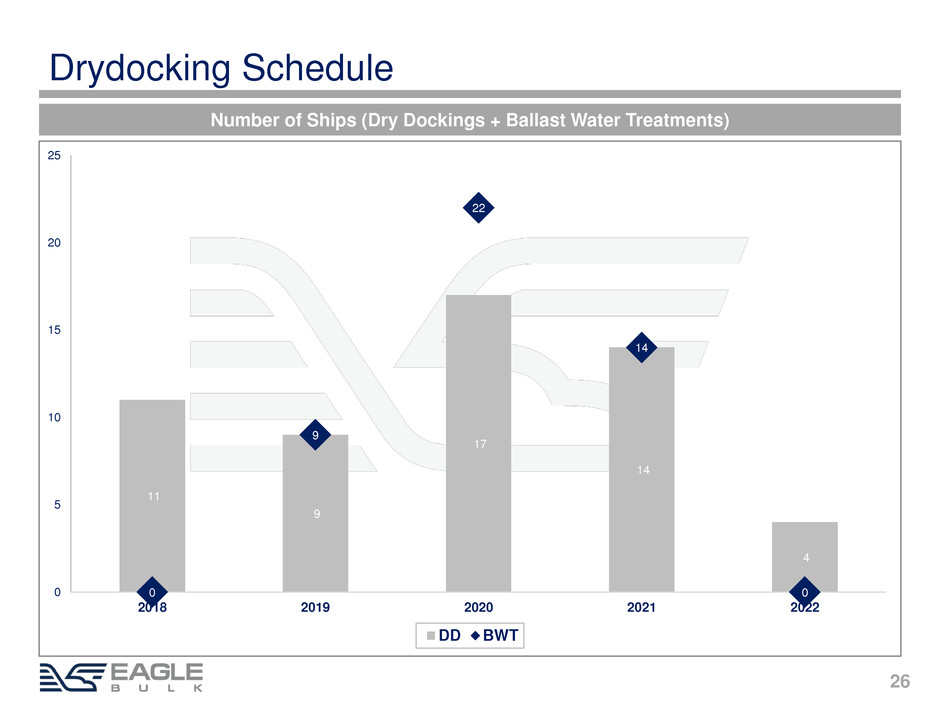
26
Drydocking Schedule
Number of Ships (Dry Dockings + Ballast Water Treatments)
11
9
17
14
4
0
9
22
14
0 0
5
10
15
20
25
2018 2019 2020 2021 2022
DD BWT
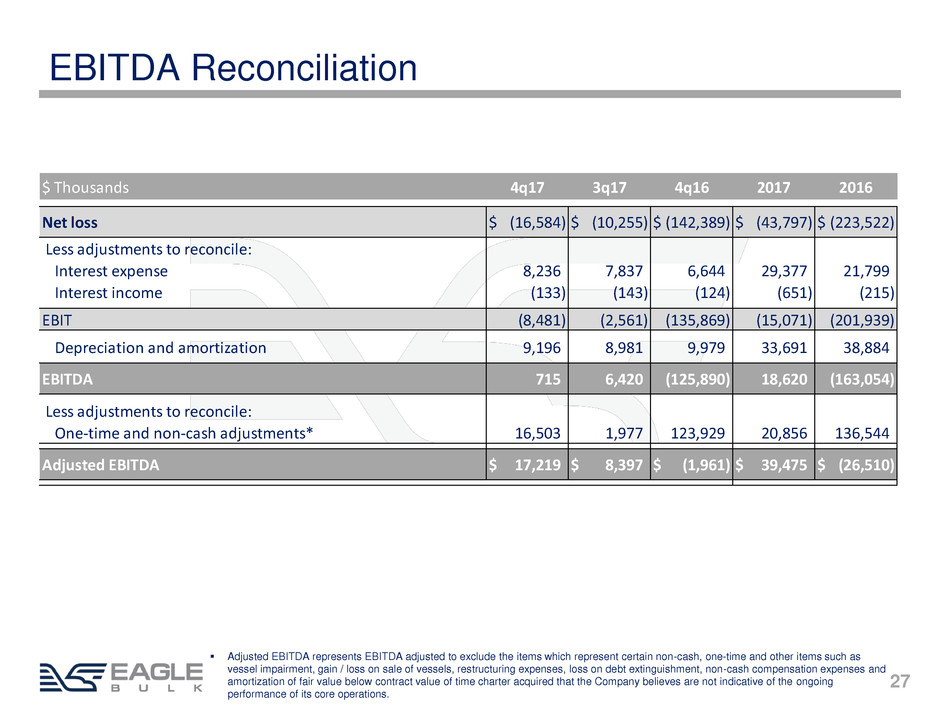
27
EBITDA Reconciliation
$ Thousands 4q17 3q17 4q16 2017 2016
Net loss (16,584)$ (10,255)$ (142,389)$ (43,797)$ (223,522)$
Less adjustments to reconcile:
Interest expense 8,236 7,837 6,644 29,377 21,799
Interest income (133) (143) (124) (651) (215)
EBIT (8,481) (2,561) (135,869) (15,071) (201,939)
Depreciation and amortization 9,196 8,981 9,979 33,691 38,884
EBITDA 715 6,420 (125,890) 18,620 (163,054)
Less adjustments to reconcile:
One-time and non-cash adjustments* 16,503 1,977 123,929 20,856 136,544
Adjusted EBITDA 17,219$ 8,397$ (1,961)$ 39,475$ (26,510)$
Adjusted EBITDA represents EBITDA adjusted to exclude the items which represent certain non-cash, one-time and other items such as
vessel impairment, gain / loss on sale of vessels, restructuring expenses, loss on debt extinguishment, non-cash compensation expenses and
amortization of fair value below contract value of time charter acquired that the Company believes are not indicative of the ongoing
performance of its core operations.

28
TCE Reconciliation
Owned available days is the number of our ownership days less the aggregate number of days that our vessels are off-hire due to
vessel familiarization upon acquisition, repairs, vessel upgrades or special surveys.
$ Thousands except TCE and days 1q16 2q16 3q16 4q16 1q17 2q17 3q17 4q17
Revenues, net 21,278 25,590 35,788 41,836 45,855 53,631 62,711 74,587
Less:
Voyage expenses (9,244) (7,450) (11,208) (14,192) (13,353) (13,380) (17,463) (18,155)
Charter hire expenses (1,489) (1,668) (3,822) (5,866) (3,873) (6,446) (9,652) (11,312)
Reversal of one legacy time charters 1,045 793 670 432 (302) 584 329 426
Realized gain/loss on FFAs and bunker swaps - - (449) (113) - 83 248 (349)
TCE revenue 11,590 17,265 20,979 22,097 28,326 34,473 36,173 45,197
Owned available days * 3,945 3,902 3,700 3,653 3,620 3,771 4,177 4,324
TCE 2,938 4,425 5,670 6,049 7,825 9,142 8,660 10,452

29
Definitions
Adjusted EBITDA
Adjusted EBITDA is a non GAAP financial measure that is used as a supplemental financial measure by our management and
by external users of our financial statements, such as investors, commercial banks and others, to assess our operating
performance as compared to that of other companies in our industry, without regard to financing methods, capital structure or
historical costs basis. Our Adjusted EBITDA should not be considered an alternative to net income (loss), operating income
(loss), cash flows provided by (used in) operating activities or any other measure of financial performance or liquidity presented
in accordance with U.S. GAAP. Our Adjusted EBITDA may not be comparable to similarly titled measures of another company
because all companies may not calculate Adjusted EBITDA in the same manner. Adj. EBITDA represents EBITDA adjusted to
exclude certain non-cash, one-time, and other items (such as vessel impairment, gain / loss on sale of vessels, restructuring
expenses, loss on debt extinguishment, non-cash comp, and amortization of TC acquired) that Eagle believes are not
indicative core operations.
TCE
Time charter equivalent ( the "TCE") is a non-GAAP financial measure that is commonly used in shipping industry primarily to
compare daily earnings generated by vessels on time charters with daily earnings generated by vessels on voyage charters,
because charter hire rates for vessels on voyage charters are generally not expressed in per-day amounts while charter hire
rates for vessels on time charters generally are expressed in such amounts. The Company defines TCE as shipping revenues
less voyage expenses and charter hire expenses, adjusted for the impact of one legacy time charter and gains on FFAs and
bunker swaps, divided by the number of owned available days. TCE provides additional meaningful information in conjunction
with shipping revenues, the most directly comparable GAAP measure, because it assists Company management in making
decisions regarding the deployment and use of its vessels and in evaluating their financial performance. The Company's
calculation of TCE may not be comparable to that reported by other companies.
Owned available days is the number of our ownership days less the aggregate number of days that our vessels are off-hire
due to vessel familiarization upon acquisition, repairs, vessel upgrades or special surveys. The shipping industry uses
available days to measure the number of days in a period during which vessels should be capable of generating revenues.

FROM TO FROM TO FROM TO
BSI-52
1 50,000 55,000 94.0% 100.0% 85.0% 90.0%
2 55,000 60,000 98.0% 107.0% 92.0% 100.0%
3 60,000 65,000 112.0% 120.0% 112.0% 116.0%
52,000 100.0%
VESSEL TYPE INDEX FACTOR
(AS COMPARED TO THE BSI VESSEL)
SHIP TYPE
SIZE (DWT)
JAPANESE CHINESE
30
Evaluating TCE Relative Performance
Supramax/Ultramax TCE Performance Matrix
This page is meant to assist analysts/investors on how to potentially evaluate and forecast vessel/fleet
TCE relative performance within the Supramax/Ultramax segment
For Illustrative Purposes Only
A Chinese 60-65k DWT Ultramax should earn a
premium of 12-16% to the net BSI-52, depending
on its specific design characteristics, due to
cargo carrying capacity, speed, and fuel
consumption differences
The BSI-52 is based on the 52k DWT Japanese
TESS-52 design Supramax and is gross of
commissions
Matrix depicts the estimated TCE
Earnings Performance range for a
generic Supramax/Ultramax vessel type
as compared to the BSI-52 ship
Since the Supramax/Ultramax segment is comprised of a number of different ship types / sizes / designs, TCE
generation ability can differ significantly from the standard vessel used to calculate the BSI-52 benchmark
For example, a 2013-built Chinese 60-65k DWT Ultramax should be expected to earn a significant premium to
a 2013-built 55-60k Supramax, particularly given the incremental cost of the 60-65k DWT vessel
Ultimately, it’s about yield – the expected earnings ability of a vessel versus its cost
The Matrix is meant to capture general ship types but there are likely some vessels which fall outside the stated figures
Index Factors can change somewhat with movements in both fuel prices and (spot) rate environment

60
65
70
75
Dec-13 Dec-14 Dec-15 Dec-16 Dec-17 Dec-18
Actual Period Average
70
75
80
85
90
95
100
105
110
Dec-13 Dec-14 Dec-15 Dec-16 Dec-17 Dec-18
Actual Period Average
31
Trade figures in million MTs /2018 data is forecasted
Source(s): Bloomberg, Clarksons
Minor Bulks Represent ~38% of Drybulk Trade
Salt Trade Cement Trade
Petcoke can be used as a substitute
for coal in power generation
Bauxite Trade Petcoke Trade
100
105
110
115
Dec-13 Dec-14 Dec-15 Dec-16 Dec-17 Dec-18
Actual Period Average
42
44
46
48
50
52
54
Dec-13 Dec-14 Dec-15 Dec-16 Dec-17 Dec-18
Actual Period Average
Trade expected to grow by 4% Y/Y
Chile is a major exporter of salt
Bauxite trade expected to
increase by 10% Y/Y
Cement trade is directly correlated
with infrastructure and
construction developments
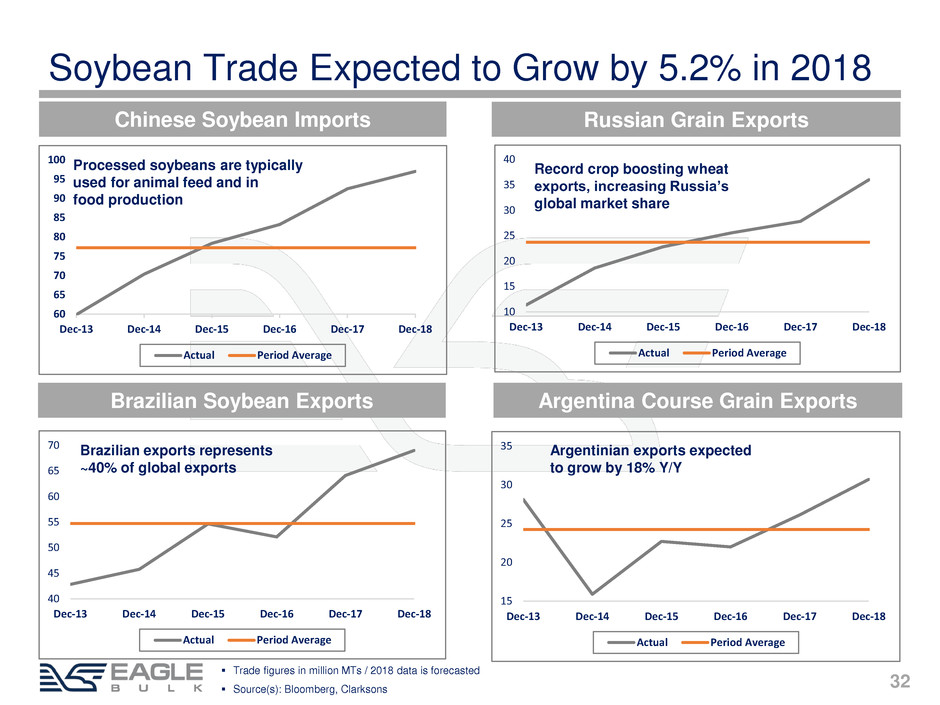
10
15
20
25
30
35
40
Dec-13 Dec-14 Dec-15 Dec-16 Dec-17 Dec-18
Actual Period Average
60
65
70
75
80
85
90
95
100
Dec-13 Dec-14 Dec-15 Dec-16 Dec-17 Dec-18
Actual Period Average
40
45
50
55
60
65
70
Dec-13 Dec-14 Dec-15 Dec-16 Dec-17 Dec-18
Actual Period Average
32
Trade figures in million MTs / 2018 data is forecasted
Source(s): Bloomberg, Clarksons
Soybean Trade Expected to Grow by 5.2% in 2018
Argentina Course Grain Exports
Chinese Soybean Imports Russian Grain Exports
Processed soybeans are typically
used for animal feed and in
food production
Brazilian Soybean Exports
Brazilian exports represents
~40% of global exports
Record crop boosting wheat
exports, increasing Russia’s
global market share
15
20
25
30
35
Dec-13 Dec-14 Dec-15 Dec-16 Dec-17 Dec-18
Actual Period Average
Argentinian exports expected
to grow by 18% Y/Y

50
60
70
80
90
100
110
Jan-13 Jan-14 Jan-15 Jan-16 Jan-17 Jan-18
Actual Period Average
China has continued to import higher
quality iron ore per environmental
regulations
500
700
900
1,100
1,300
1,500
Feb-13 Feb-14 Feb-15 Feb-16 Feb-17 Feb-18
Actual Period Average
270
280
290
300
310
320
330
Dec-12 Dec-13 Dec-14 Dec-15 Dec-16 Dec-17
Actual Period Average
33
Iron Ore Imports
Coastal Bulk Freight Index
Trade figures in million MTs
Source(s): Bloomberg, Clarksons
China Expected to Grow by 6.6% in 2018
Coal Imports
Imports driven by increased
construction and infrastructure
Monthly imports hovering around
their 5-yr average
Rates trading above 5yr average
Minor Bulk Imports
Increase in imports driven by higher
demand of bauxite, manganese ore,
and forest products
5
10
15
20
25
30
35
Jan-13 Jan-14 Jan-15 Jan-16 Jan-17 Jan-18
Actual Period Average

www.eagleships.com
